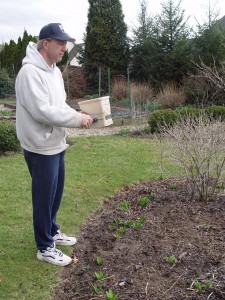George Interrogated
September 29th, 2015
I made my National Public Radio debut earlier this month, appearing as the gardenish guest on WHYY’s Radio Times program in Philadelphia.
It was an interesting, question-filled experience – starting with the lady who welcomed me inside the studio door, continuing with insightful questions by host Mary Cummings-Jordan, and ending with a zip line of Tweeters, e-mailers and old-fashioned phone caller-inners.
Lots of people apparently have lots of questions when it comes to gardening. I got some really good and timely ones, too, which got me thinking that if these folks were wondering about these things, you might be as well.
If you’d like to hear the whole hour-long show, it’s available free for the listening online at WHYY’s Radio Times website.
But if you just want to scarf up some quick pointers, here’s the Cliff Notes version:
Q: My hydrangeas didn’t bloom very well the past two years. Am I pruning them wrong or was it the weather?
A: Both of those can de-flower your hydrangeas, assuming we’re talking about the common big-leaf types with the pink or blue flower balls.
This type of hydrangea forms flower buds the fall before, so a cold winter can freeze the already-formed buds. That happened widely the past two winters. But fall, winter or early-spring pruning cuts them off.
If you’re betting on a third cold winter in a row, build a burlap corral around your hydrangea(s) and stuff it with leaves as insulation.
Pruning-wise, cut these hydrangeas only right after they flower (or should have flowered). That means July or early August at the latest. Don’t even think about pruning them now.
Q: Is fall a good time to fertilize?
A: Not in most cases. Spring is much better.
An end-of-season lawn fertilizer is fine, and there’s an OK window between the time plants go dormant in fall (leaf drop of trees is a cue) and when the ground freezes, which can deliver nutrients to the root zone when plants are ready to grow again next season.
But in general, you don’t want to encourage growth in early fall by fertilizing, especially with fast-acting, water-soluble chemical fertilizers.
My main fertilizer regimen is either compost or a granular, organic fertilizer over my landscape beds once a year in early spring.
Q: My neighbor cut down a lot of trees last year, and the two rhododendrons in front of my house really suffered over the winter from all of the wind that resulted. One of them died, and the other looks beat up. Anything I can do to protect them this winter?
A: The best bet to deal with your new wind tunnel is to erect a burlap wall between the prevailing wind and your rhodie. That’ll mitigate the wind.
You might also think about planting your own evergreen windbreak for the long haul. You’ll have some control over whether that one stays or goes.
Some people might suggest a spray-on protectant such as Wilt-Pruf, but I think these have minimal – if any – effect as a winter-wind aid.
Q: I’ve been reading that the traditional advice of tilling the vegetable garden every year is wrong. I’d be curious to get your opinion.
A: I agree with that. Regular tilling stirs up weed seeds, pulverizes the soil (actually making it more prone to compaction), causes organic matter to decompose faster, and disturbs earthworms and other beneficial soil organisms.
I think tilling makes sense in creating a bed in the beginning – when you have to loosen compacted “builder’s soil” and work in enough compost or similar organic matter to bring the soil back to life and good tilth.
But once your beds are built and slightly raised and “fluffy,” don’t walk on them, and don’t keep tilling them. I just top my vegetable garden with an inch or so of fresh compost at the end of every season and let the earthworms be my “tillers.”
Q: Is fall really a good time to plant or is that advice mainly garden centers trying to get rid of plants before winter?
A: Yeah, garden centers would like to sell their plants instead of store them, but “fall is for planting” is not hype at all.
September through the end of October is an excellent planting window because the temperatures are cooling (less shock on transplanted plants), the soil is still warm (good for root growth), and we usually get more rain (keep the hose handy in case we don’t). It’s a side benefit that a lot of plants go on sale as we get deeper into October.
The main exception is borderline-hardy plants (cherry laurel, nandina, crape myrtle, aucuba, osmanthus, etc.) These would rather not face cold winds soon after being planted.
That doesn’t mean you can’t plant even those, though. It just means the odds are less.
Ditto for planting beyond October. Don’t thing that everything will live if you get it in the ground by Oct. 31 but will all die if you wait until Nov. 1. The survival odds just get lower the later you go.
Q: When is it time to start fall cleanup in the yard?
A: There is no set date. You can do whatever work needs done as soon as each plant needs it.
For example, if you have annuals that are looking ratty already, yank them now. Same with diseased or browned-out perennial foliage – cut it now.
When frost hits, you’ll have a lot to do all at once, including yanking all of the dead annuals and vegetables, lifting the tender bulbs, and clipping frost-killed perennial foliage.
But some plants tolerate frost and look good into and even through winter, so let those alone until they “tell” you they need attention.
Don’t overdo it either. There’s a difference between cleanup and sanitizing. I like to let some seed heads and dead foliage up over winter for food and shelter for birds. And I don’t rake leaves out of shrub and perennial beds; they’re excellent winter insulation. Leaves on the lawn get mowed in, and leaves that pile up on evergreen groundcovers get dumped in my compost pile.
One thing not to do in fall is prune. Put the pruners away until at least leaf drop, and better yet, end of winter, or for early spring-blooming shrubs, right after bloom.
Q: When is it time to bring in the houseplants?
A: The most tender varieties should go back inside when nighttime lows dip below 50 degrees, which is usually around now.
All tropicals and houseplants should go back inside when nighttime lows start flirting with 40 degrees.
And the drop-dead date is the season’s first frost. Most houseplants will croak when even briefly exposed to freezing temperature. Pay attention to the forecast. In an average year, Harrisburg gets its first fall frost around the third week of October.









